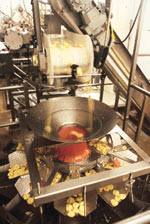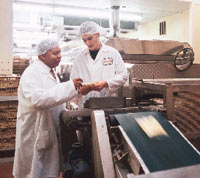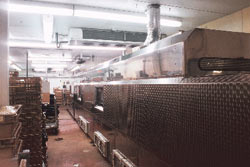
But fewer consumers are turning to fast-food restaurants for prepared takeout meals. FMI reports that the percentage of shoppers purchasing takeout meals "most often" from fast-food restaurants fell from 48 percent in 1996 to 34 percent this year, while the percentage of those purchasing takeout meals "most often" from supermarkets rose from 12 to 18 percent over the same period.
Supermarkets have expanded their prepared-food offerings over the past several years through alternative approaches ranging from in-store preparation to in-house or third-party commissaries to purchasing packaged HMRs and their components from manufacturers -- frequently a combination of all three.

Romance Foods Co. of Kenosha, Wis., has successfully marketed minimally-processed refrigerated food products for the past decade. The company manufactures pasta and sauce products microwave-pasteurized in barrier-plastic film packages to retain "al dente" texture and achieve a 75-day refrigerated shelf life, while requiring only 2 to 3 minutes of microwave reheating by the consumer.


'Full circle' to pasta
Founded in 1989 as a unit of Johnsonville Foods (Kohler, Wis.), Romance Foods was acquired in Oct. '99 by West Point graduate and former B-52 pilot Robert B. Ramsay, an MBA who honed his management skills at Fortune 500 firms like General Motors, Philip Morris and CitiBank and aspired to run his own company. After teaching finance and entrepreneurship in the economics department at Hartwick College in upstate New York, Ramsay managed federal prison factories for the U.S. Dept. of Justice, then headed defense contractor Steeltech Co. (a Milwaukee firm with a $1 billion contract for U.S. Army vehicles) before purchasing Romance Foods from Johnsonville last year. "We made pasta and sauce at home when I was a kid growing-up in a large family in Brooklyn," recalls Ramsay, now owner, president and CEO of Romance Foods. "So you might say I've come full-circle."
Johnsonville established its pasta business back in '89 as a hedge against a possible downturn in its basic sausage business, Ramsay continues, and converted its Kenosha sausage plant to produce pasta. Fresh-pasta recipes and microwave-pasteurization technology were acquired from Europe. Last year, Johnsonville decided to focus on its core meat businesses and sold Romance Foods to Ramsay.
Pasta varieties available today include shelf-stable (dry and canned), frozen and fresh -- the newest category -- with the fresh category gaining on frozen, Ramsay observes. "Nestle with its Contadina brand and Kraft with DiGiorno became the leaders in the fresh-pasta category," he continues. "But we're the only fresh cooked pasta. Unlike the others, our products are microwaveable by the consumer. They fit the HMR 'grab-and-go' market with heat-and-serve convenience. Our goals are to grow the business and educate the consumer."Romance Foods manufactures pasta with 30 employees on one shift operating two processing and packaging lines supplied by any of three pasta-production lines.

Flexible production
In the process room, pasta ingredients such as Semolina durum wheat flour, eggs and water are mixed in a horizontal ribbon blender and the dough toted to fillers supplying sheeters on any of three Toresani pasta lines: one for long goods, one for Ravioli, one for Tortelloni and Tortellini (which differ mainly in size and shape of the shell). The process room has space for an additional pasta line. Fillings incorporating ingredients such as chicken, beef, cheese and seasonings are blended and cooked in two 30-gal. Groen kettles and pumped to hoppers supplying the filled-pasta machines.At the time of Food Engineering's visit, the plant was producing Tortelloni on a six-lane Toresani form/fill machine dispensing filled shells onto a belt conveyor feeding one of two water/steam blanchers, where the product is mildly treated at 170-175 degrees F to retard enzymatic action. From blanching, the product is conveyed through a Robins rotary cold-water cooler and up an inclined conveyor to an Oshida combination weigher atop a Triangle vertical form/fill/seal machine which fills, nitrogen-flushes and seals the pasta in Cryovac LLDPE/EVOH oxygen-barrier bags at a speed of 60 10-oz. pouches per minute. (Packaging speeds vary with pouch size, which ranges from 10-oz. retail to 2-lb. food-service capacities.)
From the packaging machines, pouches are conveyed through Advanced Detection metal detectors and into one of two 60-ft. Omac conveyorized microwave tunnels, which combine continuous microwave heating with convection heating for pasteurization, and then cool the product. PLC control varies conveyor speed to vary microwave-treatment time, which differs for each product, and assures product-exit temperature at 163 degrees F.

Pouches emerging from a microwave tunnel are manually transferred to another belt conveyor feeding a Labelaire machine, which applies the classic Romance label (featuring Michaelangelic cherubs tenderly engaged in "the first kiss") to one side of the pouch, an ingredient/nutritional label to the other, and prints a "freeze or use by" date on the pouch. The Romance label for filled pastas informs consumers that the product is "fully cooked al dente," contains "no artificial ingredients," is "minimally processed," and the product can be reheated via "boil or microwave in just two minutes."
Labeled pouches are manually loaded into stackable dollied basketrays and rolled into one of two 800-sq.-ft. blast coolers, where product temperature is lowered to less than 40 degrees F in less than four hours -- a critical control point in the plant's HACCP program. Dollied baskets are then rolled to the cartoning line where pouches are manually cased and cases sent through a taping machine for immediate shipment. "We manufacture to order, not to inventory," Ramsay points out.
Sauces are prepared and packaged in a separate room equipped with ingredient-processing equipment including a Sidelman cheese cutter and three 80-gal. Groen kettles. After cooling, prepared sauces are pumped directly from kettles to a hopper supplying a Key-Pack vertical form/fill/seal machine which cold-fills sauces into Cryovac pouches ranging from a 6-oz. retail size to a 3-lb. food-service package. Sauce pouches are labeled, trayed and dollied to a microwave line for pasteurizing and subsequent cooling. "We're looking at more co-pack opportunities," says Ramsay. "One possibility is a chili concentrate."
Critical control points in the plant's HACCP program include in-process temperatures, especially at packaging, and cooling finished products to below 40 degrees F in less than four hours. Shelf-life tests are conducted in the plant's small lab, and finished-product samples are sent to Silliker Laboratories for microbiological testing.
Finished products are shipped to customers in trailers capable of maintaining product temperature at or below 40 degrees F, says Ramsay. Some customers pick-up at the Romance plant, other products are shipped via common carriers such as Veteran's and DFC -- a unit of Dean Foods.
Formulation Barriers:
- Acidulation
- Antioxidants
- Humectants
- Competitive
- Microorganisms
- Dips & sprays
- Irradiated spices
- Blanched components
- Preservative treatments:
- Sodium benzoate
- Potassium sorbate
- Sodium nitrite
- Sodium lactate
- Nisin
- Lysozyme
- Liquid smoke
- Proprionates
- Post-packaging
- Pasteurization
- Hot-fill/quick-chill (cook/chill)
- Emerging technologies:
- Microwave pasteurization
- Irradiation
- Ultra-high pressure
- pasteurization
- High-intensity pulsed light
- Pulsed electrical fields
- Oscillating magnetic fields
- Ultra-violet light
- Modified atmosphere packaging (MAP)
- Incorporation of materials into packaging films and trays to minimize transfer of oxygen, moisture, light, etc.
- "Clean room" packaging
- "Active" packaging:
- Oxygen scavengers
- Ethanol or carbon-dioxide emitters
- Preservatives incorporated into packaging materials
- Superchill holding conditions (28-33 degrees F)
- Distribution system options:
- Direct store delivery (DSD) in dedicated trucks
- Frozen product providing controlled thaw during distribution
- Time/temperature monitors
- Inventory management system
- Minimized case counts
- Store-level support and training